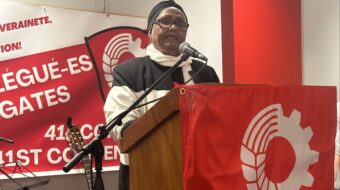Opinion
Carrying on anti-war activity in this very white, very conservative enclave in rural Penn’s Valley, Penn., is remarkably different from what I have experienced before – more than a decade of activism in Chicago, and two decades in Mississippi. I’m writing from my office in Bellefonte, across a mountain and a historical and cultural continental divide from Penn’s Valley.
My residence is in Spring Mills, a tiny idyllic village at the foot of a mountain beside the confluence of Sinking Creek and Penn’s Creek, where the most prominent landmarks are church steeples and an elementary school. A small factory is located across the street from my apartment, and the main hangout is a tavern called the Frosty Hook.
A vigil each Saturday morning at the main crossroads in Millheim, one town to the east of Spring Mills, draws from 15 to 18 people. Horse-drawn buggies with Amish drivers clatter down the street past our pickets, as do tankers full of milk from nearby farms. Some drivers honk in solidarity, others scowl at us. Last week we convened afterward at Gaffron’s Sunrise Café in Aaronsburg, operated by peace supporters, to write protest postcards to the White House.
My town is located in Gregg Township. Aaronsburg is located in adjacent Haines Township. Last October, Haines Township’s elected leaders had adopted a resolution opposing a preemptive U.S. military attack on Iraq. In February an angry mob of conservative protesters compelled them to repeal it. So the issues of war and peace are hotly debated hereabouts, and anti-war signs in people’s front windows compete with their neighbors’ implicitly pro-war U.S. flags.
The ride to Washington for yesterday’s [March 15] anti-war demonstration was an inspiring experience for me. Departing from our rendezvous point in a caravan that had started out from Penn State University, 37 of us boarded the bus at Mifflintown, which is more than double the number who have participated in the weekly vigils at Millheim.
The two principal organizers of this group were the youngest and oldest riders, a young woman who attends high school in State College and a 77-year-old Mississippi-born retired union organizer from Mifflintown. Joining us were a Lutheran pastor from Juniata County, an attorney from Port Royal, college students from Lewisburg and Selinsgrove, young workers from Lewistown, and peace activists from Aaronsburg, Coburn and Centre Hall.
Several had never before attended a national demonstration.
Others compared the turnout and the speeches and the music to previous experiences of the ’60s, ’70s, and ’80s. Among our number were opponents of abortion and supporters of Zionism as well as pacifist and leftists.
On the ride home I had a spirited exchange with some of the younger people on the subject of affirmative action. The most skeptical among them was an African American college graduate who worries that the taint of affirmative action will brand her as less qualified than white counterparts at whatever career she pursues. She and her friends seemed surprised that I consider white people to be as much the beneficiaries of affirmative action as the previously excluded oppressed people.
We also debated the pros and cons of restricting and outlawing racist agitation. These were not people who shared a single purpose or ideology, so the protest journey provided a useful context for political education and exchange.
To put all this into perspective for myself, I recall that when I joined the first picket line against the Vietnam War, in 1963 in Chicago, fewer people came than participate each Saturday at Millheim, before the main assault on Iraq has even begun. From such beginnings we can only grow.
Ken Lawrence is a writer in Bellefonte, Penn. He can be reached at Apsken@aol.com. This article was written March 16.









